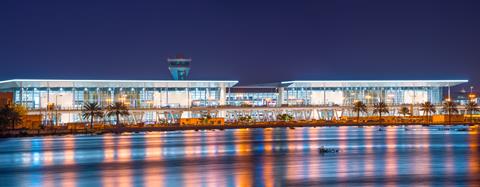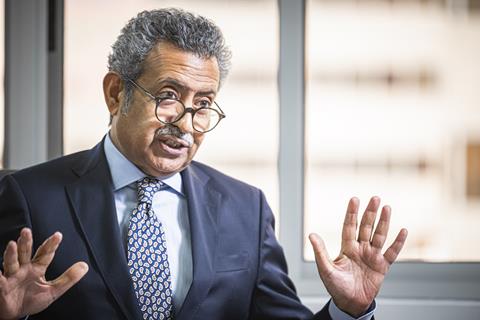It may not be a mega-hub like Dubai or Doha, but Bahrain airport is looking to the next stage of its expansion, less than four years after the opening of its new terminal. On the agenda are hotels, runway improvements, an enhanced customer offer, and an expanded cargo centre
Bahrain’s impressive $1.1 billion terminal has been open less than four years but already Mohamed Yousif Albinfalah is anticipating what comes next. Outside his office, the chief executive of Bahrain Airport Company (BAC) stands over a giant model that shows how the airport estate might look by the turn of the decade.

He points out potential landside locations for a new hotel, shopping complex, and apartments, as well as the eventual layout of a Cargo Village north of the runway – phase one of which has just been completed. While he admits some of the plans are “at an early stage”, there is no doubting Bahrain’s aim to boost its credentials as an aviation hub and continue diversifying its economy from fossil fuel exports into growing sectors such as high-end tourism and logistics.
A picture of Bahrain’s airport from the 1980s, a time when the country was still the main destination for airlines in the Arabian Peninsula – the emergence of Abu Dhabi, Doha, and Dubai as global aviation hubs only began this century – shows little northeast of the runway but desert and scrubland rolling towards the sea.
Since then, a series of land reclamations, new highways, and housing and hotel construction on the island of Muharraq has seen entire new communities and artificial islands take shape around the airport, stretching for 2km into the waters of the Gulf.
The new terminal opened in January 2021 – the 210,000sq m (2,260,000sq ft) light-filled building replacing its next-door 1970s-era predecessor. The latter, though loved by many regular passengers for its cosiness, was operating at almost twice its design capacity and was largely demolished to make way for the new structure.
It was the first step in a growth plan that will also see an extension to the single runway in the next few years and its upgrading from ICAO Category 2 to Category 3, which “will give us more resilience in adverse weather”, says Albinfalah. Also on the cards is phase two of the Cargo Village, and further development east of the terminal.
Additionally, last year saw the opening of a new private aviation terminal – a refurbishment of an even older main airport building dating from 1961 that previously housed the country’s civil aviation administration offices (see photo spread in tomorrow’s issue), and the construction of a royal pavilion.
Albinfalah is looking forward to welcoming more passengers to a terminal that was built to handle 14 million passengers and 130,000 air traffic movements a year – more than three times the traffic the previous terminal was designed for. This year, BAC expects passenger numbers to be 9.6 million, which is still slightly down on the pre-Covid 2019 total of 9.7 million, but Albinfalah insists progess is steady “despite all the headwinds”.

The terminal continues to “look fresh” and is “very efficient and customer friendly”, according to Albinfalah. “Everything is paying off for us, based on feedback and third-party appraisals,” he says. This includes a top five-star rating from airport review organisation Skytrax every year since opening. “In a region where there are lots of mega hubs, we are very gratified by this performance,” he adds.
ATTRACTING NEW AIRLINES
Home airline Gulf Air still makes up about two-thirds of traffic, but the airport has been attracting new airlines. An easing of political tensions with neighbour Qatar – diplomatic relations between the two countries were restored in 2023 – has seen that country’s flag-carrier renew its connection with Doha. Meanwhile, Azerbaijan Airlines, Ethiopian, Iraqi Airlines, Royal Jordanian, and Smart Wings have all begun services in the past two years.
The recent Routes World event hosted by Bahrain in early October also brought hundreds of airport executives and airline network planners to the country, many of whom, says Albinfalah, were visiting the new terminal for the first time, and gave his team the “chance to develop new relationships”.
He expects growth in passenger numbers in 2025 and 2026 to be around 5% a year, “in line with the rest of the industry”, although he says the airport could surpass its 14 million official capacity with technological improvements such as passenger recognition systems and an extension of a check-in-at-home programme, which would “help us reduce congestion at crunch points”.
Nearer term plans include a third premium lounge for credit card and lounge-card partners, freeing up the existing facility for airlines (Gulf Air has a dedicated lounge). In October, BAC issued tender documents for a project to extend a taxiway that serves as an emergency runway. This will allow the airport to resurface the main runway at a later date without disrupting operations significantly.
BAC will officially launch phase two of its Cargo Village development on the north side of the runway in December. Under phase one – which has seen some 58,000sq m or about three-fifths of the total planned site developed – FedEx Express has already moved into two warehouses. The hope is to attract other operators (see Cargo Feature P18), transforming the airport into a major regional hub for air freig


























